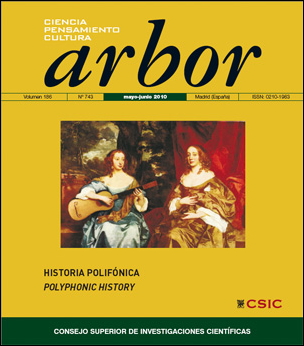How the mind works: The visual representaion of brain processes
DOI:
https://doi.org/10.3989/arbor.2010.743n1208Keywords:
Neuroscience, visualization, neuroimagologyAbstract
This paper offers an account on the history of visualization, in particular the visualization of brain activity, through a description of different sets of theories and techniques, dating back to the nineteenth century up to the present day, designed to represent mental processes.
Downloads
References
Barthes, Roland (1981): Camera Lucida: Reflections on Photography, New York, Farrar Straus and Giroux.
Blume, Stuart S. (1992): Insight and Industry: On the Dynamics of Technological Change in Medicine, Cambridge, MA, MIT Press.
Breidbach, Olaf (1993): Nervenzellen oder Nervennetze? Zur Entstehung des Neuronenkonzepts. En: Das Gehirn - Organ der Seele? Zur Ideengeschichte der Neurobiologie, ed. Ernst Florey y Olaf Breidbach, 81-126, Berlin, Akademie.
Burri, Regula Valerie (2008): Doing Images. Zur Praxis medizinischer Bilder, Bielefeld, Transcript.
Cartwright, Lisa (1995): Screening the Body: Tracing Medicine’s Visual Culture, Minneapolis, University of Minnesota Press.
Chadarevian, Soraya de (1994): Sehen und Aufzeichnen in der Botanik des 19. Jahrhunderts. En Der Entzug der Bilder. Visuelle Realitäten, ed. Michael Wetzel y Herta Wolf, 121-44, Munich, Fink.
Crick, Francis (1994): Was die Seele wirklich ist. Die naturwissenschaftliche Erforschung des Bewusstseins, Munich, Artemis.
Dommann, Monika (2003): Durchsicht, Einsicht, Vorsicht: Eine Geschichte der Röntgenstrahlen, 1896-1963, Zurich, Chronos.
Dumit, Joseph (2004): Picturing Personhood: Brain Scans and Biomedical Identity, Princeton, Princeton University Press.
Flusser, Vilém (1992): Ins Universum der technischen Bilder, 4th ed., Göttingen, European Photography.
Foerster, Otfried (1925): Zur Pathogenese und chirurgischen Behandlung der Epilepsie, Centralblatt für Chirurgie, 25: 531-56.
Freud, Sigmund (1955): Das Ich und das Es [1923]. En idem: Gesammelte Werke. Vol. 13, 3rd ed., London, Imago.
Freud, Sigmund (1992): Zur Auffassung der Aphasien [1891], Frankfurt a. M., Fischer.
Hagner, Michael (1994): Lokalisation, Funktion, Cytoarchitektonik. Wege zur Modellierung des Gehirns. En Objekte, Differenzen und Konjunkturen, ed. Michael Hagner, Hans-Jörg Rheinberger y Bettina Wahrig-Schmidt, 121-50, Berlin, Akademie.
Hagner, Michael (2002): “Cyber-Phrenologie. Die neue Physiognomik des Geistes und ihre Ursprünge”, en Die Politik der Maschine, ed. Klaus Peter Dencker, 182-98, Hamburg, Verlag Hans-Brednow- Institut.
Hagner, Michael (2004): Geniale Gehirne. Zur Geschichte der Elitegehirnforschung, Göttingen, Wallstein.
Hagner, Michael (2006): Der Geist bei der Arbeit. Historische Untersuchungen zur Hirnforschung, Göttingen, Wallstein. Hüsing, Bärbel, Jäncke, Lutz, y Brigitte Tag (2006): Impact Assessment of Neuroimaging, Zürich, IVT Verlag.
Penfield, Wilder y Theodore Rasmussen (1950): The cerebral cortex of man. A clinical study of localization of function, New York, Macmillan.
Munk, Hermann (1890): Über die Functionen der Grosshirnrinde. Gesammelte Mitteilungen, 2nd ed., Berlin, Hirschwald.
Monakov, Constantin von (1897): Gehirnpathologie, Wien, Hölder.
Pomian, Krzysztof (1997): Der Ursprung des Museums. Vom Sammeln, 3rd ed., Berlin, Wagenbach.
Posner, Michael I. y Marcus E. Raichle (1994): Images of Mind, New York, Scientific American Library.
Roth, Gerhard (1994): Braucht die Hirnforschung die Philosophie? En Neuroworlds. Gehirn - Geist - Kultur, ed. Jutta Fedrowitz, Dirk Matejovski, and Gert Kaiser, 81-92, Frankfurt a. M., Campus.
Schickore, Jutta (2007): The Microscope and the Eye: A History of Reflections, 1740-1870, Chicago, University of Chicago Press.
Schott, G. D. (1993): Penfield’s homunculus: a note on cerebral cartography, Journal of Neurology, Neurosurgery and Psychiatry 56: 329-333. doi:10.1136/jnnp.56.4.329 PMid:50411
Soemmerring, Samuel Thomas (1791): Abbildungen und Beschreibungen einiger Misgeburten, Mainz, Universitätsbuchhandlung.
Taylor, John (1994): Windows open on the mind over grey matter, The Times Higher Education Supplement, Multimedia December 9: iv-v.
Weigel, Sigrid (2004): “Phantombilder zwischen Messen und Deuten. Bilder von Hirn und Gesicht in den Instrumentarien empirischer Forschung von Psychologie und Neurowissenschaft”, en Repräsentationen. Medizin und Ethik in Literatur und Kunst der Moderne, ed. Bettina von Jagow y Florian Steger, 159-99, Heidelberg, Winter.
Wernicke, Carl (1874): Der aphasische Symptomencomplex. Eine psychologische Studie auf anatomischer Basis, Breslau, Cohn & Weigert.
Downloads
Published
How to Cite
Issue
Section
License
Copyright (c) 2010 Consejo Superior de Investigaciones Científicas (CSIC)

This work is licensed under a Creative Commons Attribution 4.0 International License.
© CSIC. Manuscripts published in both the printed and online versions of this Journal are the property of Consejo Superior de Investigaciones Científicas, and quoting this source is a requirement for any partial or full reproduction.
All contents of this electronic edition, except where otherwise noted, are distributed under a “Creative Commons Attribution 4.0 International” (CC BY 4.0) License. You may read the basic information and the legal text of the license. The indication of the CC BY 4.0 License must be expressly stated in this way when necessary.
Self-archiving in repositories, personal webpages or similar, of any version other than the published by the Editor, is not allowed.














